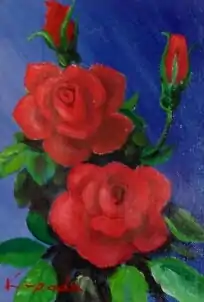Jutaro Kuroda
Jutaro Kuroda (黒田 重太郎, Kuroda Jūtarō, 1887–1970) was a Japanese artist.[1] After studying art with the two Japanese masters of Yōga art at his time, namely Kanokogi Takeshiro and then Asai Chū,[2] Kuroda went to Europe from 1914 to 1918 and intensified his Western-style painting practice, adopting a style most closely following the style of French painter Camille Pissarro.[3] It was on his second journey that he became a pupil of the French Cubist artist André Lhote. Upon his return to Japan, Kuroda introduced Cubism to his homeland and became a central figure in the art circles in Kyoto from the late Meiji to the Showa era as a particularly accomplished water-colourist and oil painter.

Bara ("Rose") (Private Collection, Japan)
See also
References
- "Jutaro Kuroda". Christie's. Retrieved 2017-08-11.
- "Section 1: Artists who learned from France | Modern Japan and France―adoration, encounter and interaction". ndl.go.jp. Retrieved 2017-08-11.
- "Independent brushstrokes". The Japan Times. Retrieved 2017-08-11.
This article is issued from Wikipedia. The text is licensed under Creative Commons - Attribution - Sharealike. Additional terms may apply for the media files.